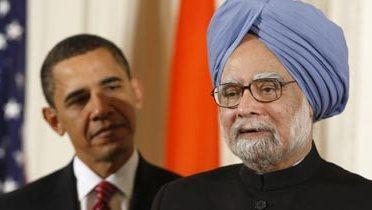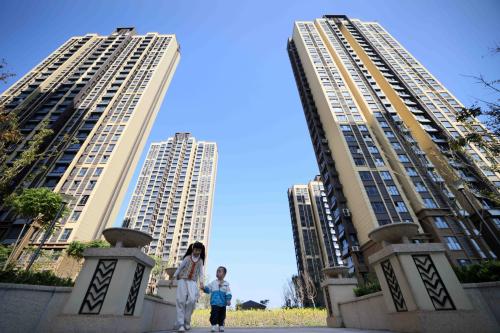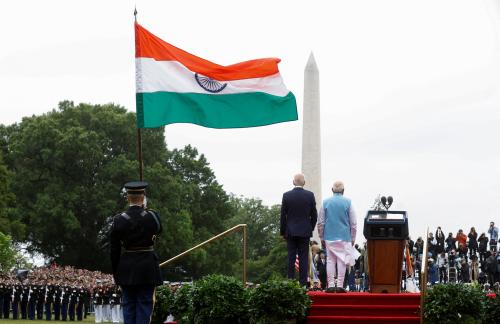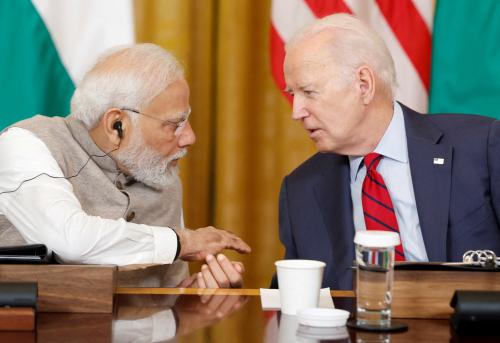President Obama’s visit to the world’s largest democracy comes at a time when prospects for the world economy are becoming increasingly reliant on leading emerging markets like India, and when India’s economic and political clout in global affairs is growing. Flows of goods, services and people have strengthened the economic interdependence between the two countries, although this is still an order of magnitude smaller than the U.S.-China interdependence.
There are natural alliances between the two countries on a range of economic and political issues, but the relationship still needs some careful nurturing. This visit by President Obama provides an opportunity to build trust and convince Indian leaders that the U.S. has a genuine interest in promoting a more cooperative approach on issues where the two sides agree and dealing with some irritants in the relationship. The nature of the strategic relationship between the U.S. and India could play an important role in shaping a number of international policy debates, especially as the U.S. sees India as a counterweight to China.
Here are some highlights of the strategic and economic aspects of the bilateral relationship:
- Economic ties between the two countries are growing. Trade in services and skilled migration are the key components of these growing linkages. Trade between the two countries is roughly balanced, reducing the potential for conflict on currency and trade issues. Indian officials are now very concerned about loose monetary policy in the U.S., which is fueling surges in capital flows into India and creating concerns about an unsustainable boom in equity markets.
- Indian citizens are by far the largest skilled migrant group in the U.S., accounting for over one-third of U.S. H-1B visas issued in recent years. Even as the U.S. benefits enormously from this import of skills, tensions are rising about high-end service sector employment that is moving from the U.S. to India. This could become a potent issue if employment growth remains weak in the U.S.
- President Obama needs to reassure India that the U.S. is not just a fair-weather friend. India has major concerns about security on its borders with Pakistan and China. Indian leaders are not convinced that, in the event of rising tensions on either of these borders, the U.S. will throw in its lot with India.
- India has so far taken a relatively passive role in international policy debates where the U.S. would like it to be more assertive—for instance, in the currency wars. Here again, India is hesitant to lead the charge on behalf of other emerging markets as it feels somewhat isolated and is nervous about being left out in the cold, including by the U.S., if it takes an aggressive position against China.
- Most of the conflicts between India and the U.S. are in fact played out on the international stage rather than on specific bilateral issues. The U.S. sees India as blocking progress on the trade liberalization and climate change agendas. This is one area where constructive cooperation and give-and-take between the two economies could have global implications.
Key Elements of the Bilateral Economic Relationship
Trade
U.S.-India trade has expanded in recent years but took a hit during the crisis and has only recently begun to rebound. Trade in goods and services between the countries has been quite balanced, with India running a surplus of around $7 billion (See Figures 1 and 2 in pdf).
The share of total Indian exports going to the U.S. has declined steadily from around 20 percent at the beginning of the decade to about 11 percent over the last two years. The increase in India’s exports to China, especially minerals such as iron ore, accounts for part of this shift. Less than 2 percent of U.S. exports go to India. Services trade between the two economies has been growing rapidly—the share of total U.S. services imports that come from India has risen from less than 1 percent in 2000 to 3.4 percent in 2009.
Migration
Indian citizens are by far the largest skilled migrant group in the U.S. In 2009, the number of H-1B visas awarded to Indian citizens totaled 123,002, or 36 percent of all H-1B visas awarded that year, up from a share of about 25 percent in 2005 (See Figures 3 and 4 in pdf). The bias toward Indians in the allocation of H1B visas to the U.S. is no coincidence—it reflects the complementary relationship between skilled Indian immigrants and advanced, high growth sectors in the U.S., most notably information technology services.
Travel and Tourism
In addition to the flow of migrant workers and services, tourism is another area that is helping to foster rising linkages between the U.S. and India. American tourist expenditures (both business and leisure) in India amounted to about $2.5 billion in 2009, accounting for roughly 20 percent of U.S. services imports from India in 2009. Indian tourist expenditures in the U.S. have increased to $3 billion, or 30 percent of services exports to India. These numbers are another testament to the small and growing but relatively balanced nature of the U.S. and Indian economic relationship.
The State of the Indian Economy
India has bounced back sharply from a mild growth slowdown during the global financial crisis. GDP growth was 6 percent in 2009 and could hit 10 percent in 2010 (See Figure 5 and Table 1 in pdf), led by robust industrial production growth. The big concern is inflation, which is now running in double digits (See Figure 6 in pdf). Food price inflation triggered the inflationary surge, which has now become more broad-based. India has been receiving large amounts of capital inflows in the last few months, leading to concerns about a bubble building up in the equity market and increasing appreciation pressures on the currency, which could hurt the manufacturing sector and exports. Indeed, industrial production growth has shown some signs of slowing down in the last couple of months (See Figure 7 in pdf).
The Bombay Stock Exchange has been running hot in recent weeks, with the main stock index (SENSEX) reaching levels comparable to its pre-crisis peak. Surges in capital inflows have fueled the equity market boom and led to sharp appreciation pressures on the currency (See Figures 8 and 9 in pdf). A rising currency could of course help contain inflationary pressures but at the cost of hurting exports, which are crucial for job growth. India has recently raised interest rates to try and tamp down inflation but this could induce more capital inflows. The government has indicated that it is seriously considering capital controls to try and block some of the inflows and mitigate the complications they create for domestic macroeconomic management.
India has good short-term growth prospects if it can manage to keep inflation from getting out of hand. But there are many longer-term challenges—public finances that are in dire need of repair, inadequate physical infrastructure, weak public governance (corruption), restrictive labor laws and a relatively under-developed financial system. Moreover, for India to reap the demographic dividend of a relatively young workforce, the education system has to be overhauled in short order to increase skill levels among the workforce. These challenges will have to be dealt with forcefully for India to meet its own version of the G-20 goal of robust, balanced and sustainable growth, with the benefits of that growth shared by the entire population rather than a select few.





